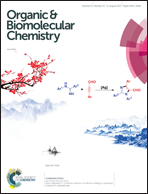Improved i-motif thermal stability by insertion of anthraquinone monomers†
Abstract
In order to gain insight into how to improve thermal stability of i-motifs when used in the context of biomedical and nanotechnological applications, novel anthraquinone-modified i-motifs were synthesized by insertion of 1,8-, 1,4-, 1,5- and 2,6-disubstituted anthraquinone monomers into the TAA loops of a 22mer cytosine-rich human telomeric DNA sequence. The influence of the four anthraquinone linkers on the i-motif thermal stability was investigated at 295 nm and pH 5.5. Anthraquinone monomers modulate the i-motif stability in a position-depending manner and the modulation also depends on the substitution pattern of the anthraquinone. The insertion of anthraquinone was found to stabilize the i-motif structure when replacing any one of the positions of the central TAA loop and the thermal stabilities were typically higher than those previously found for i-motifs containing pyrene-modified uracilyl unlocked nucleic acid monomers or twisted intercalating nucleic acid. The 2,6-disubstituted anthraquinone linker replacing T10 enabled a significant increase of i-motif thermal melting by 8.2 °C. A substantial increase of 5.0 °C in i-motif thermal melting was recorded when both A6 and T16 were modified with a double replacement by the 2,6-isomer into the TAA loops in the outer regions. The largest destabilization is observed for the 1,5-disubstituted anthraquinone linker upon the replacement of A18. CD curves of anthraquinone-modified variants imply no structural changes in all cases under potassium buffer conditions compared with those of the native i-motif. Molecular modeling studies explained the increased thermal stabilities of anthraquinone-modified i-motifs.



 Please wait while we load your content...
Please wait while we load your content...